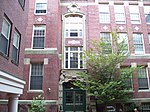Massachusetts General Hospital

Massachusetts General Hospital (Mass General or MGH) is the original and largest teaching hospital of Harvard Medical School located in the West End neighborhood of Boston, Massachusetts. It is the third oldest general hospital in the United States and has a capacity of 999 beds. With Brigham and Women's Hospital, it is one of the two founding members of Mass General Brigham (formerly known as Partners HealthCare), the largest healthcare provider in Massachusetts. Massachusetts General Hospital conducts the largest hospital-based research program in the world, with an annual research budget of more than $1 billion in 2019. It is currently ranked as the #5 best hospital in the United States by U.S. News & World Report.In November 2017, The Boston Globe ranked MGH the fifth best place to work out of Massachusetts companies with over 1,000 employees.
Excerpt from the Wikipedia article Massachusetts General Hospital (License: CC BY-SA 3.0, Authors, Images).Massachusetts General Hospital
Fruit Street, Boston West End
Geographical coordinates (GPS) Address Phone number Website External links Nearby Places Show on map
Geographical coordinates (GPS)
| Latitude | Longitude |
|---|---|
| N 42.362805555556 ° | E -71.068630555556 ° |
Address
Massachusetts General Hospital
Fruit Street 55
02114 Boston, West End
Massachusetts, United States
Open on Google Maps







